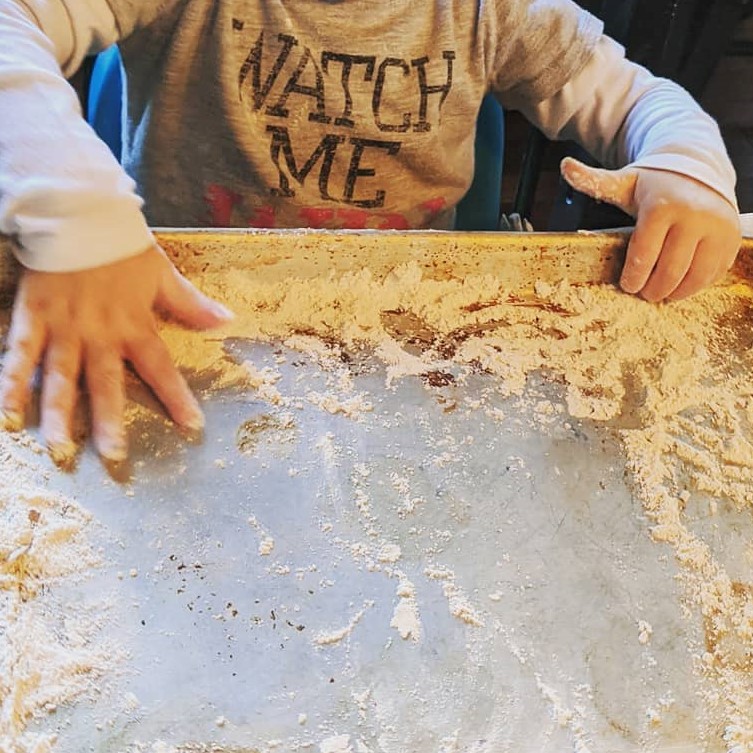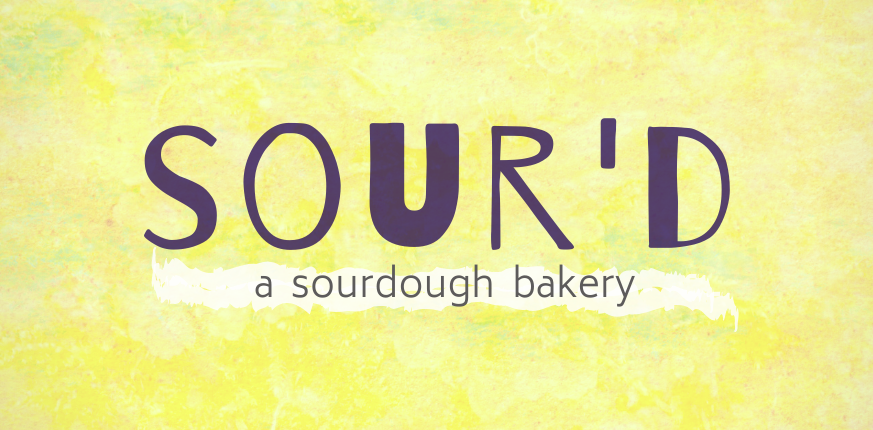
I believe that it’s easier to make sourdough if you’ve had experience with baking other bread. I think this has to do with all the variables in bread baking. Bread is affected by humidity, temperature, water quality, the hands that are handling the bread, etc. Sourdough, it seems, is even more susceptible to those things. It will be helpful to know what bread dough is supposed to feel like and look like.
Through all my sourdough research (which has been mainly focused on making and maintaining a starter) I’ve found that there are many opinions… some people weigh the water and flour every time they add it to their starter. Some people measure. Some people just throw in a little of each. The general consensus is equal parts starter to flour, and half the amount of non-chlorinated water. I have read posts from people who say that they’ve neglected their starter for months at a time, then started it back up again… in that case, you would throw all but a couple of tablespoons out and start to build the starter up again. It stinks to think about throwing away any starter, but for me it was comforting to know that even if you think a starter is dead, there is a strong possibility that it could be brought back to life.
There’s a ton of information out there, but I think researching the maintenance of a starter has helped me learn the most about sourdough.
How to Make a Starter
It has been so long since I made my starter. I thought I had documented my process, but I can’t find that anywhere. I know that I used all purpose flour and water, and that it took about a week.
How to Feed a Starter
For the first several years, I fed my starter like this:
1 cup starter, 1 cup unbleached all-purpose flour, 0.5 cup water.
My starter was fine and active, but I don’t feed it like this anymore.
Now, I feed mine like this:
Equal parts (measured in grams) *flour to water to starter.
*50/50 mix of unbleached bread flour and whole wheat flour
I generally keep 9-12 grams of starter. I pour my discard into a jar in the fridge, and when that’s full, I use it to make sourdough waffles or pancakes. 9-12 grams is not very much, but I almost always make a leaven when I make bread.
The First Sourdough Bread I Made:
(This is originally from King Arthur Flour, but I cannot seem to find it on their website anymore. That recipe included sugar. Coincidentally, a friend of mine who knew about sourdough sent me her mom’s recipe which was the same exact thing as this one, except it had honey instead of sugar.)
MIX AND LET SIT AT ROOM TEMPERATURE FOR 4-5 HOURS, AND THEN OVERNIGHT IN THE FRIDGE:
1 cup fed and ready Sourdough Starter (it should have doubled, and will float in water when it’s ready)
3 cups Unbleached Bread Flour
1.5 cups Water
THE NEXT MORNING:
- Add 2.25 teaspoons salt, and 1 tablespoon of sugar or honey. Mix and Knead for about 10 minutes, until the dough is smooth and elastic, and passes the windowpane test (you should be able to stretch the dough until it is so thin you can see through it without the dough breaking.)
- Let this dough sit until doubled (a few hours at room temperature)
- Divide the dough in half.
- Shape the dough (https://www.youtube.com/watch?v=wx5I5O_RoeI)
- Put the dough into loaf pans (Recommended: aluminized steel USA loaf pan, or similar alternative. These pans shouldn’t have to be greased.)
- Let rise, covered with a dish towel, in a warm environment for 2-4 hours (this could take longer. It will be ready when the dough has about doubled.)
- Bake at 425 F for 25 minutes. The bread should sound hollow when tapped from the bottom. Internal done temperature for bread is 200 F.
*A warm environment can be created by turning on the pilot light in your oven. Alternatively, you can almost always put bread dough in the fridge for 8-10 hours until you’re ready to bake it. In that case, you would cover with a dish towel and then a plastic bag to make sure it stays moist but doesn’t collect too much condensation on the surface.
………….
King Arthur Flour: https://www.kingarthurbaking.com/recipes/sourdough
The Perfect Loaf: https://www.theperfectloaf.com/7-easy-steps-making-incredible-sourdough-starter-scratch/
This Pilgrim Life: https://www.thispilgrimlife.com/how-to-make-sourdough/
Pans for Sandwich Bread: https://www.amazon.com/USA-Pan-1140LF-Bakeware-Aluminized/dp/B0029JQEIC
Pans for Artisan Bread: https://www.amazon.com/Lodge-Cooker-Pre-seasoned-Skillet-Convertible/dp/B0009JKG9M/ref=sr_1_1?dchild=1&keywords=cast+iron+combo+cooker&qid=1595785157&s=music&sr=1-1 (or you can just use a Dutch oven)
Recipes
Really really good bread, kind of complicated, but the video is very informative. https://food52.com/recipes/80565-table-loaf
The first artisan sourdough that I made. This is a pretty simple recipe: https://anoregoncottage.com/easy-sourdough-artisan-bread/
Helpful Instagram Accounts
There are so many of these, but here are three that I have found helpful on the information front:
@jess .wagoner (some really great shaping videos in her highlights)
@tartinebakery (they did a series of posts that show how to make a starter and how to make their “country loaf” – that same bread has been made in various YouTube videos too. Search: Tartine Country Bread)
@sour_flour (I really love her scoring artwork)
Buy Good Flour
In the beginning of my sourdough journey, I used plenty of King Arthur Flour. I even used Gold Medal Flour sometimes, always going for the “unbleached” variety. You can bake with any flour, but the best results are truly going to come from locally sourced, stone-milled grains. Mostly, I use Lindley Mills Hi Gluten Bread Flour. I also use their Whole Wheat Bread Flour, Super Sprout Whole Wheat Flour, and their Malted X.
Here is a list of mills around the U.S. from which to buy flour. There may be others, but here is a start at least: https://ritualfinefoods.com/pages/resources
The Sourdough Podcast
Fun, informative, and very encouraging!
https://www.thesourdoughpodcast.com/
